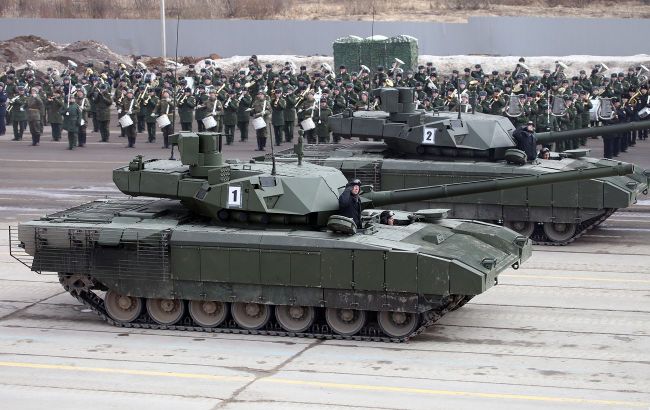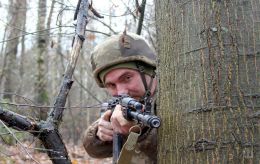Russia has limited defense industry, but still able to maintain army readiness - ISW
 Russian tanks T-14 Armata (photo: wikipedia.org)
Russian tanks T-14 Armata (photo: wikipedia.org)
Russia currently has a limited defense industrial base for the production of weapons and an insufficient number of serial lines for tank production. However, this does not prevent the aggressor from producing a sufficient amount of equipment at the current pace to support its military efforts in the medium and long term, according to the Institute for the Study of War (ISW).
Ukrainian military observer Kostiantyn Mashovets noted that the Russian defense-industrial base is not as productive as the Kremlin portrays it, but it remains capable of sustaining the combat potential of the Russian army.
According to the Security Council, Russia's defense industry reached its production peak in September 2023, exceeding the average monthly production volume in 2022 by 38.9%, and steadily declined in the following months.
Mashovets stated that the Russian defense industry is trying to compensate for the shortage of medium- and high-skilled labor, as well as the inability to obtain necessary industrial production equipment, spare parts, and service support to maintain the pace and volume of arms production.
According to the observer, Chinese companies are less willing to provide equipment and spare parts to Russia. Western companies are unwilling to service or supply parts for these machines due to sanctions. However, the aggressor acquired many industrial production systems from Western countries before the full-scale invasion of Ukraine.
Old tanks from the warehouse
Military analyst Oleksandr Kovalenko noted that the reported production volumes of tanks in recent years by Russia mostly consist of refurbished and modernized machines taken from storage rather than new samples of armaments.
According to the expert, the main Russian tank manufacturer, Uralvagonzavod, under ideal conditions, can produce approximately 60-70 T-90 tanks per year. This means that the enterprise produces from three to six new tanks of this model monthly.
Tank producers Uralvagonzavod, Omsktransmash, and the 103rd Armored Tank Repair Plant in Chita (Zabaykalsky Krai) focus on refurbishing, repairing, and modernizing existing tanks. Meanwhile, Uralvagonzavod is currently the only producer of new tanks.
Additionally, Kovalenko pointed out that Russia only modernizes T-54/55 and T-62 tanks, which could potentially become the main combat vehicles of its army in the future.
"Russian manufacturers very rarely modernize T-72 and T-80 tanks. Russian Security Council Deputy Chairperson Dmitri Medvedev previously stated that Russian forces received 1,600 tanks in 2023, and Kovalenko attributed this number primarily to restored and modernized rather than serially produced tanks," the ISW report stated.
Modernization and numerical advantage
Experts at the Institute also note that Russia is capable of modernizing and deploying tanks withdrawn from storage, giving its forces an advantage on the battlefield in terms of quantity.
Ukrainian military observer Kostyantyn Mashovets pointed out that some new tanks, such as the T-14 Armata, are poorly manufactured. Instead, Russia actively repairs old tanks, like the T-72, which are more reliable.
Furthermore, Russia consistently seeks to adapt to the limitations imposed by Western sanctions and will continue to try to circumvent them.
"Russia’s DIB may struggle in the near term, and increasing sanctions evasion measures and partnerships with states including China and North Korea may help compensate for existing DIB shortcomings in the medium to long term," the ISW report states.
Defense potential of Russia
Earlier, it was reported that the Russian defense-industrial complex could produce at least 100 main battle tanks per month.
According to the latest data from the Ukrainian Air Force, Russia still possesses around 900 precision long-range missiles.
The General Staff of the Ministry of Defense reported that Russian forces have not used Kalibr cruise missiles to strike Ukraine since mid-September 2023, likely to conserve missile reserves.

